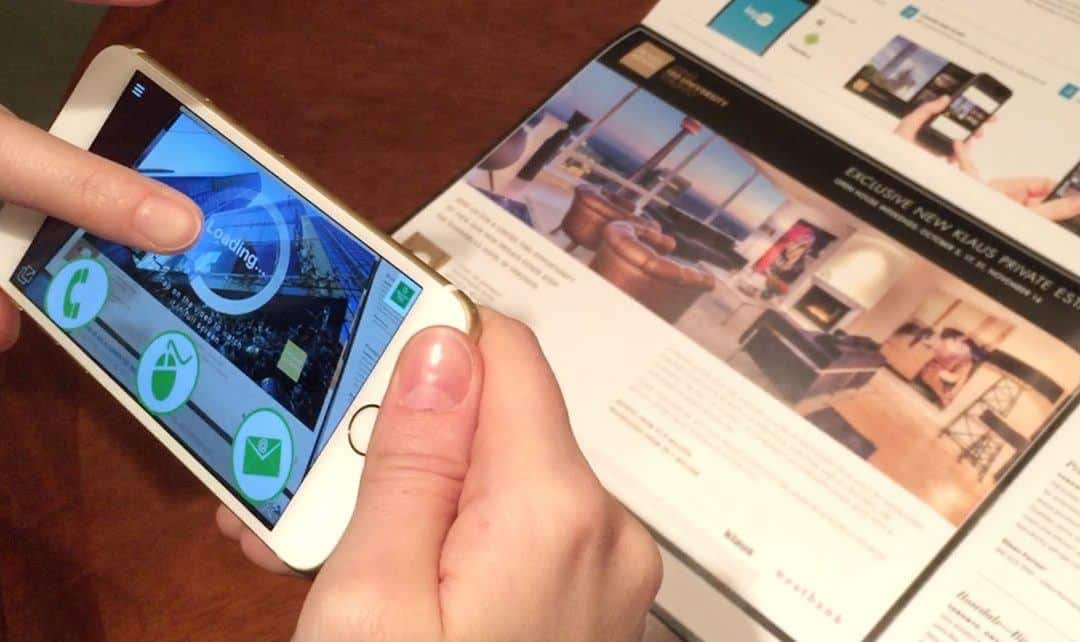An app that provides information through videos about a property, its neighbourhood, the listing agent and the realty company is bringing new life to print publications and other print formats.
It can also provide real estate professionals with data on prospective buyers, says Debbie McGrath, marketing director of Toronto-based Chestnut Park Real Estate, which has embraced the technology known as augmented reality (AR).
She says that in the “very congested” real estate market in cities like Toronto, AR can give sales reps and brokers “a real competitive edge.”
Chestnut Park, an affiliate of Christie’s International Real Estate, is using an AR app called Layar, brought to it by Commersive Solutions. Jason Elmaleh, president of the Toronto-based company, says Layar is activated by simply hovering a camera on a smartphone (iOS, Android or BlackBerry10 Device) or tablet over an “enabled image” in print format.
“Trigger images (which could be a photo of a property or even a headshot of the listing agent) can provide layers of information to the reader” about Chestnut Park, or its properties for sale at the Shangri-La Toronto luxury condo, or a listing agent, says McGrath.
“The most amazing part of AR is bridging the gap between real life and virtual life,” says Elmaleh. “Now users can see more than what is conveyed in print.”
Chestnut Park recently introduced the app through print editions of its property listing magazine, Invest in Style. While it was too early to measure the impact of the app at press time, McGrath says if 30 to 35 per cent of the readers use the app, it will be a success.
She says the app, which collects data on the user on a weekly or monthly basis, provides agents with stats of engagements, where the listing was viewed, for how long and who viewed it. “Suddenly that connection with the consumer becomes so much smoother and more efficient.”
She says, “The cost benefit becomes very clear because you can use it on a number of different (print format) platforms.”
Another plus is that Layar clarifies the impact of the ad for salespeople. “We know immediately whether anyone has interacted with it, unlike direct mail in which you hope someone is going to call you.”
Elmaleh sees “huge potential” for the app in the real estate industry. “The beautiful thing about AR is that it can be tailored to anything. Real estate is an excellent venue with limitless possibilities – making a home buying and selling experience interactive, seamless and more informative.”
He adds that because the app offers “immediate information” prospective buyers don’t have to spend time doing research online. “The more educated the buyer is, the better it is for the buyer and the seller.”
The app will also prove useful for sales of yet-to-be-built projects, such as a condo development in the Toronto neighbourhood of Leaside at which Chestnut Park is selling units. “It shows you a video of renderings – what’s to come,” says McGrath. The video also gives consumers a flavour for the neighbourhood, including everything from nearby retail to main transportation routes.
While Layar is easy to set up and free for users, the cost to agents is comparable to the price of the design of a basic website, Elmaleh says, noting that the final tab is determined by the amount of content and features an agent wants.
Augmented reality has been around for many years. It has been popular in Europe for many types of marketing. IKEA’s catalogue, for example, employs AR technology, providing users with a number of features, including a type of virtual reality experience to determine how a piece of furniture might best fit into their home’s layout.
“You can take a scan from the catalogue and hold your iPod up in your room and move the furniture around with your finger to fit in your room, and change the colours,” says McGrath, adding that IKEA has recently introduced AR technology to its catalogue in Toronto.
Elmaleh says his company had been following AR for years and after much research found that Layar was a global leader. “Key bugs have been fixed and it allows for a smoother user experience.”
While some brokers and agents might approach the new app with a wary eye, thinking it might be a gimmick rather than something that will improve their business, McGrath says it could prove a valuable tool in the right hands. “When you think of our market of buyers, we have the luxury condo group but we also have a ton of millennials and we all know that they are digitally focused so it is a very easy adoption for that group.
“I think the next generation will grow up knowing that print has become more dynamic than what is flat on the page,” she adds.
Elmaleh says as camera technology and operating software advance, AR technology will be able to offer even more features for the user. “I see interactive 3D models of homes popping out of the page, allowing for a potential homebuyer to click to view various rooms of the house or condos.”
While that technology is here already, he says it is unreliable because of the limitations of smart devices. “I see a bright future for AR, especially as people become more accustomed to the technology.”
Don Procter is a contributing writer for REM.


















